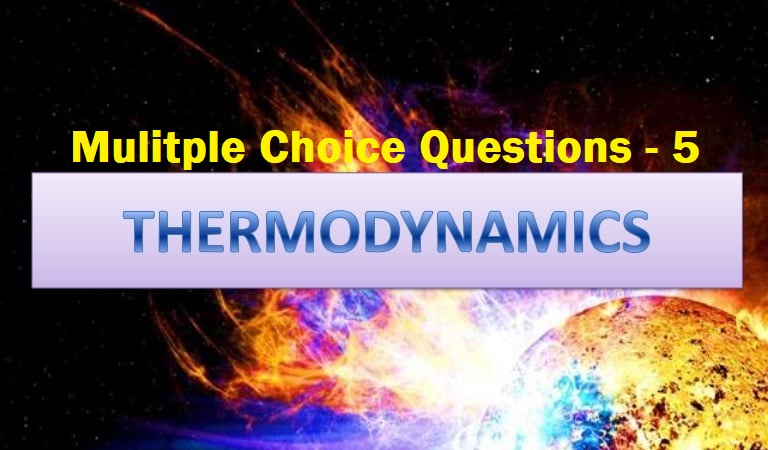CBSE Class 11 Chemistry Chapter 6 Thermodynamics Multiple Choice Questions with Answers. MCQ Questions Class 11 Chemistry Thermodynamics with Answers was Prepared Based on Latest Exam Pattern. Students can solve NCERT Class 11 Chemistry Thermodynamics MCQs with Answers to know their preparation level.
Students who are searching for NCERT MCQ Questions for Class 11 Chemistry Thermodynamics with Answers are compiled here to get good practice on all fundamentals. Know your preparation level on MCQ Questions for Class 11 Chemistry with Answers. You can also verify your answers from our provided MCQ Class 11 Chemistry Thermodynamics with Answers. So, ace up your preparation with MCQ of Chapter 6 Chemistry Objective Questions.
MCQ Questions Class 11 Chemistry Thermodynamics with Answers - Set - 5
Question 1:
For the reaction H2(s) ⇌ H2O(l) at 0°C and normal pressure
(a) ∆H < T∆S
(b) ∆H = ∆G
(c) EH = T∆S
(d) ∆H > T∆S
Correct Answer – (C)
Question 2 :
2 mol of an ideal gas at 27°C is expanded reversibly from 2 L to 20 L. Find entropy change (R = 2 cal/mol K) in cal K-1 mol-1
(a) 92.1
(b) 0
(c) 4
(d) 9.2
Correct Answer – (D)
Question 3 :
In thermodynamics a process is called reversible when
(a) Surroundings and system change into each other
(b) There is no boundary between system and surroundings
(c) The surroundings are always in equilibrium with the system
(d) The system changes into surroundings spontaneously
Correct Answer – (C)
Question 4 :
In a closed insulated container, a liquid is stirred with a paddle to increase the temperature. Which of the following is true?
(a) ∆E = W ≠ 0, q = 0
(b) ∆E = W = q ≠ 0
(c) ∆E = 0, W = q ≠ 0
(d) W = 0, ∆E = q ≠ 0
Correct Answer – (A)
Question 5 :
C(diamond) → C(graphite) ∆H = -ve. This shows that
(a) Graphite is more stable than diamond
(b) Diamond is more stable than graphite
(c) Both are equally stable
(d) Stability cannot be predicted.
Correct Answer – (A)
MCQ Questions Class 11 Chemistry Thermodynamics with Answers
Question 6 :
Which of the following is not a state function
(a) ∆G
(b) ∆E
(c) W
(d) H
Correct Answer – (C)
Question 7 :
Entropy change involved in the conversion of 1 mol of liquid water at 373 K to vapour at the same temperature will be (∆Hvap = 2.257 kJg-1)
(a) 0.119 kj
(b) 0.109 kj
(c) 0.129 kj
(d) 0.120 kj
Correct Answer – (B)
Question 8 :
For an endothermic reaction ∆S is positive, the reaction is
(a) feasible when T∆S > ∆H
(b) feasible when ∆H > T∆S
(c) feasible at all temperature
(d) Not feasible at all
Correct Answer – (A)
Question 9 :
Enthalpy of neutralisation of HCl with NaOH is x. The heat evolved when 500 ml of 2N HCl are mixed with 250 ml of 4N NaOH will be
(a) 500x
(b) 100x
(c) x
(d) 10x
Correct Answer – (C)
Question 10 :
Compounds with high heat of formation are less stable because
(a) It is difficult to synthesise them
(b) Energy rich state leads to instability
(c) High temperature is required to synthesise them
(d) Molecules of such compounds are distorted
Correct Answer – (B)
- NCERT Solutions Class 11 Chemistry Chapter 1 : Some Basic Concepts of Chemistry
- NCERT Solutions Class 11 Chemistry Chapter 2 : Structure Of The Atom
- NCERT Solutions Class 11 Chemistry Chapter 3 : Classification of Elements and Periodicity in Properties
- NCERT Solutions Class 11 Chemistry Chapter 4 : Chemical Bonding and Molecular Structure
- NCERT Solutions Class 11 Chemistry Chapter 5 : States of Matter
- NCERT Solutions Class 11 Chemistry Chapter 6 : Thermodynamics
- NCERT Solutions Class 11 Chemistry Chapter 7 : Equilibrium
- NCERT Solutions Class 11 Chemistry Chapter 8 : Redox Reactions
- NCERT Solutions Class 11 Chemistry Chapter 9 : Hydrogen
- NCERT Solutions Class 11 Chemistry Chapter 10 : The s-Block Elements
- NCERT Solutions Class 11 Chemistry Chapter 11 : The p-Block Elements
- NCERT Solutions Class 11 Chemistry Chapter 12 : Organic Chemistry: Some Basic Principles and Techniques
- NCERT Solutions Class 11 Chemistry Chapter 13 : Hydrocarbons
- NCERT Solutions Class 11 Chemistry Chapter 14 : Environmental Chemistry




